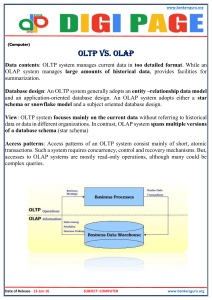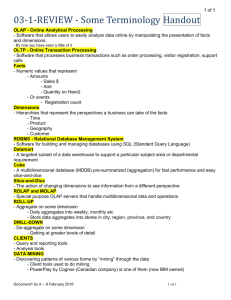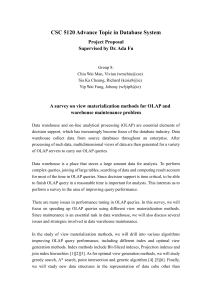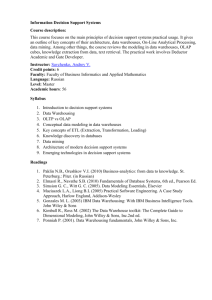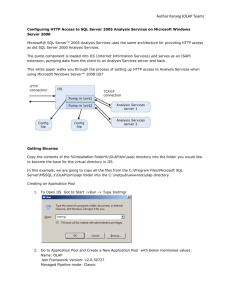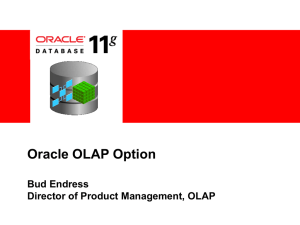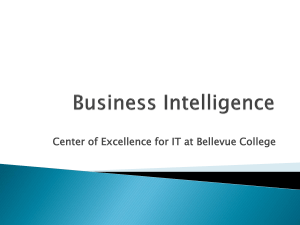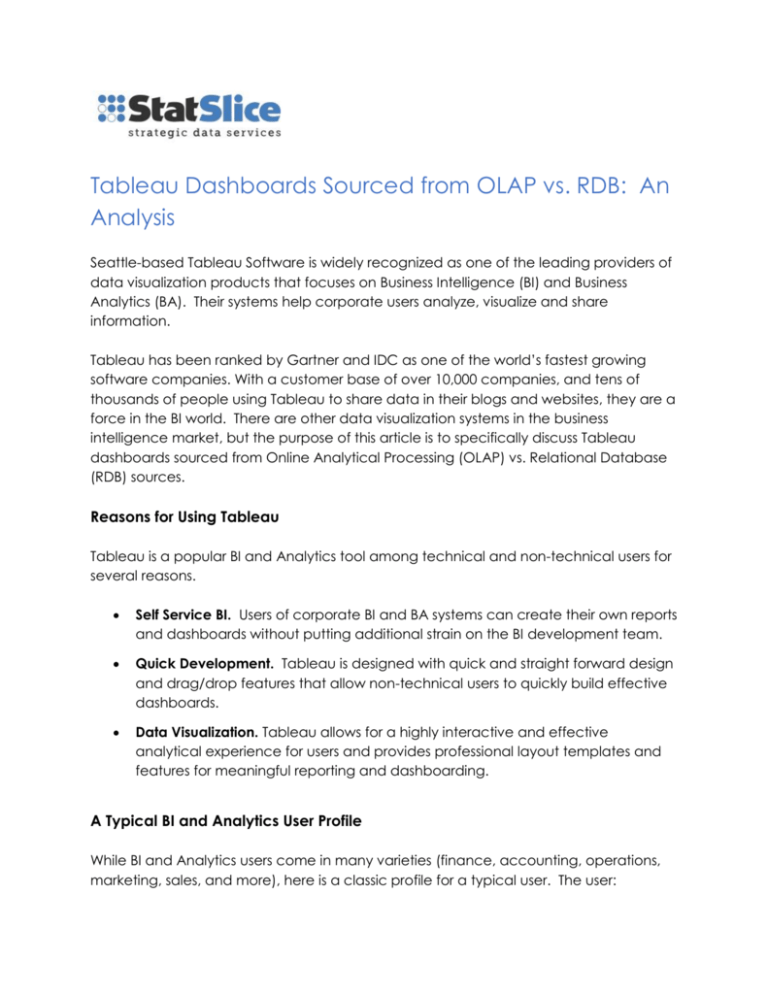
Tableau Dashboards Sourced from OLAP vs. RDB: An
Analysis
Seattle-based Tableau Software is widely recognized as one of the leading providers of
data visualization products that focuses on Business Intelligence (BI) and Business
Analytics (BA). Their systems help corporate users analyze, visualize and share
information.
Tableau has been ranked by Gartner and IDC as one of the world’s fastest growing
software companies. With a customer base of over 10,000 companies, and tens of
thousands of people using Tableau to share data in their blogs and websites, they are a
force in the BI world. There are other data visualization systems in the business
intelligence market, but the purpose of this article is to specifically discuss Tableau
dashboards sourced from Online Analytical Processing (OLAP) vs. Relational Database
(RDB) sources.
Reasons for Using Tableau
Tableau is a popular BI and Analytics tool among technical and non-technical users for
several reasons.
Self Service BI. Users of corporate BI and BA systems can create their own reports
and dashboards without putting additional strain on the BI development team.
Quick Development. Tableau is designed with quick and straight forward design
and drag/drop features that allow non-technical users to quickly build effective
dashboards.
Data Visualization. Tableau allows for a highly interactive and effective
analytical experience for users and provides professional layout templates and
features for meaningful reporting and dashboarding.
A Typical BI and Analytics User Profile
While BI and Analytics users come in many varieties (finance, accounting, operations,
marketing, sales, and more), here is a classic profile for a typical user. The user:
Has very little, if any, database or technical knowledge outside Microsoft Excel—
where they are often quite knowledgeable
Is not educated on relational database concepts such as tables and metrics
Has different formulas, calculations and requirements for corporate metrics—
based on their own needs or departmental needs and procedures
Needs required data to be updated frequently throughout the day in order to
make the best business decisions
Because of this typical profile, the need for a BI dashboarding system that is easy to
create, navigate and use, is very important. The platform needs to provide nearinstantaneous data query results and with data that is refreshed frequently.
Whether they realize it or not, most users also need a system that is reusable and
maintainable. All underlying components need to be reused by other tools and users.
Dimension hierarchies and business metrics should be standardized across all business
units and maintained in a central location to avoid data errors. Based on these factors,
below, you will see the pros and cons of users obtaining their reports and dashboards
from an OLAP source vs. a RDB source.
Simplified Tableau Dashboard Creation
Description
Best Source
Users do not have the expertise to build database relationships or join database
tables from a back end database.
OLAP
RDB
OLAP
Data relationships already exist
Defined hierarchies and metrics exist
RDB
User needs to re-create data relationships
All metrics and formulas need to be re-created
User needs much more technical expertise
Risk
If users are given the opportunity to create their own data relationships and metrics,
they could become confused, build the wrong data relationships, and ultimately lose
confidence in, and not use. the system.
Fast Data Query Performance
Description
Best Source
When comparing the performance of OLAP vs. RDB, it is clear that OLAP outperforms
a RDB when querying data.
OLAP
RDB
OLAP
Created specifically to aggregate data
Hierarchical data structures well-defined
Data retrieval performance exceeds that of a RDB
RDB
Fact tables can contain millions of rows which is time-consuming for a RDB to
aggregate
User needs to understand table relationships to get proper performance gains
Risk
Users do not understand the design of the RDB warehouse. If the users are given
access to build their own relationships, then it is possible for the queries to run poorly
due to invalid associations. The BI development team has typically spent many
weeks or months building a fast and robust OLAP design. The performance of the
OLAP cube will exceed querying directly against the database.
Low Latency Data
Description
Best Source
The data warehouse is continuously updated throughout the day. Often every 15
minutes for some fact tables.
OLAP
RDB
OLAP
Typically scheduled to incrementally process every 15 minutes
Typically scheduled to fully reprocess every hour
Small margin of time for data latency
RDB
Fact tables typically updated every 15 minutes/one hour
Dirty reads or locking of tables when refreshing
Risk
If Tableau is sourced to a RDB, it would need to continuously retrieve data from the
fact tables and put the new records into memory. That can create a risk that the
data is not updated frequently enough, especially with large fact tables. If Tableau
is sourced to OLAP, the user will always get the most recent dataset and without
dirty reads.
Components Exist in One Location for Reusability and Maintainability
Description
Best Source
An OLAP cube has already been created and is being utilized for other reports
within the business unit(s).
OLAP
RDB
OLAP
Allows for one version of “the truth”—one place for metric calculations and one
place for hierarchical structures
OLAP can be utilized by multiple user interfaces providing the same data, e.g.
Excel, SSRS, Tableau
Any changes to the cube will be immediately reflected in all user interfaces
RDB
All OLAP metrics and hierarchies would need to be recreated for use by
Tableau
Two versions of “the truth” would exist: OLAP and the RDB
Risk
The BI team will lose the ability to reuse OLAP components if Tableau was sourcing
the RDB. This would cause redundancy, possibly different values for metrics, and
increased development time due to the need of making changes in two places.
The chance of mistakes goes up.
Summary
If your organization has built an OLAP cube for reporting, Tableau should be sourced
from the OLAP cube rather than a relational database source due to query
performance, less user knowledge required, reusability of the OLAP components across
multiple interfaces, and the maintainability of hierarchies, metrics and calculations.
Technical References
Reference 1
http://www.biprofessional.com/2012/04/a-quick-look-at-tableau/
Conclusions
When using a RDB:
1. It takes a couple of hours to retrieve 100M records before the user can see data.
With OLAP, data will exist on demand. Advantage: OLAP
2. It seemed “at least as fast” as an OLAP cube. Advantage: OLAP
3. Users are required to be comfortable with arranging hierarchies themselves.
Advantage: OLAP
Reference 2
http://kb.tableausoftware.com/articles/knowledgebase/functional-differences-olaprelational
Conclusion
When using a RDB, many features and functionalities are exposed to the user versus
using OLAP. This is due to the user needing to recreate every single object found in
OLAP which causes extra work and redundancy. Advantage: OLAP
Reference 3
http://www.practicaldb.com/data-visualization-consulting/tableau-vs-qlikview/
Conclusion
Tableau is the ONLY advanced data visualization tool that can use SSAS cubes which
makes it a much more attractive reason to use it. Advantage: OLAP.
Reference 4
http://www.interworks.com/blogs/bbausili/2011/12/07/three-points-remember-successtableau-and-olap-cubes
Conclusions
1. By using OLAP cubes, a user will have analytical features not found when using RDB.
Advantage: OLAP
2. Users/development team would need to re-create all the formulas and metrics if not
sourced from cube which would require more work. In most environments, this is not
feasible. Advantage: OLAP
3. The BI development team knows how to code in MDX, but users do not. This would
require the development team to recreate formulas and calculations that already
exist. Advantage: OLAP
Reference 5
http://onlinehelp.tableausoftware.com/current/pro/online/enus/performance_multidimensional.html
Conclusion
The above article contains four bullet points about improving OLAP performance. The
main concern is that with large dimension members, the user should attempt to filter the
members to speed up performance. Advantage: OLAP
http://onlinehelp.tableausoftware.com/current/pro/online/enus/performance_relational.html
Conclusion
The above article contains eight bullet points about improving RDB performance. The
main concerns include: needing to aggregate metrics (not a default), creating an
extract so Tableau contains to an offline source (now stale data), and breaking up your
data into smaller pieces for easier access (not feasible in the DW). Advantage: OLAP
By Justin Taylor, StatSlice Systems
Justin, a StatSlice Manager Consultant, (www.statslice.com), has been architecting,
building and managing business intelligence projects since 1999, including solutions for
Fortune 500 companies. When Justin joined StatSlice, he was looking for an opportunity
to make a major contribution to the company and utilize his technology experience to
help clients solve their business problems. He enjoys opportunities to speak at
technology events, conferences and training. He holds several Microsoft certifications
include MCT (trainer), MCTS and MCITP certifications in SQL Server BI, and Certified
Scrum Master through ScrumAlliance.org.
For More Information
For more information about StatSlice Systems products and services, call (214) 206-9290
or email us at info@statslice.com. Please visit us at http://www.statslice.com
© 2013 StatSlice Systems. All rights reserved. This article is for informational purposes only. StatSlice makes no warranties,
express or implied, in this document.

